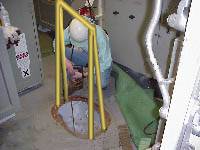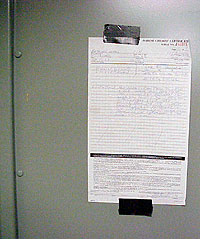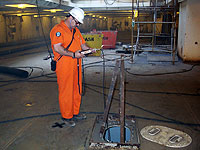Shipyard Employment eTool
Pre-Entry (Planning) >> Testing the Atmosphere

All confined spaces and many enclosed spaces require atmospheric testing before entry as well as periodic re-testing, depending on operations and conditions in and around the space.
OSHA specifies testing procedures. [29 CFR 1915.12]
Those qualified to conduct these tests include:
- Shipyard competent person (SCP)
- Certified marine chemist (CMC)
- Certified industrial hygienist (CIH)
- Coast guard authorized person (CGAP)
The Shipyard Competent Person or a Marine Chemist may conduct initial tank entry testing and hotwork testing. However, if the space contains flammable or combustible liquids or gases, a Marine Chemist must issue a certificate before hot work begins. If the Shipyard Competent Person finds a toxic atmosphere above the OSHA Permissible Exposure Limit (PEL), additional testing by the certified marine chemist or certified industrial hygienist is required and additional controls must be implemented to prevent excessive exposures. Controls typically include ventilation and personal protective equipment (PPE). [29 CFR 1915.12(c)(3)]

The employer shall ensure that atmospheric testing is performed in the following sequence: [29 CFR 1915.12]
Test records must be posted near the work being done and be available for inspection for a period of three months (for OSHA, workers, supervisors, and so forth).
According to OSHA, the following are acceptable atmospheric conditions for entry:
- Oxygen concentrations between 19.5 percent and 22.0 percent by volume. [29 CFR 1915.12]
- Flammable gas and vapor concentrations less than 10 percent of the Lower Explosive Limits (LEL). [29 CFR 1915.12]
- Toxic vapor, gas, and particulate concentrations less than the OSHA Permissible Exposure Limits (PELs) (8-hour time-weighted average PELs). [29 CFR 1915.12]
An employee may not enter a space in which the oxygen content by volume is less than 19.5 percent or more than 22.0 percent except for emergency rescue or for a short duration in order to install necessary ventilation equipment, provided that:
- The oxygen content within the space is monitored continually by volume. [29 CFR 1915.12(a)(3)]
- Respiratory protection and other appropriate PPE and clothing are provided in accordance with the PPE section of 29 CFR 1915. [29 CFR 1915.12(a)(3)]
An employee may not enter a space in which the concentration of flammable vapors or gases is equal to, or greater than 10 percent of the LEL, except for emergency rescue or for a short duration in order to install necessary ventilation equipment, provided that:
- No ignition sources are present.
- The atmosphere in the space is monitored continuously. [29 CFR 1915.12(b)(3)]
- Atmospheres at or above the upper explosive limit (UEL) are maintained. [29 CFR 1915.12(b)(3)]
- Respiratory protection and other appropriate PPE and clothing are provided in accordance with the PPE section of 29 CFR 1915. [29 CFR 1915.12(b)(3)]
An employee may not enter a space in which the concentration exceeds a PEL or is immediately dangerous to life or health (IDLH), except for emergency rescue or for a short duration in order to install necessary ventilation equipment, provided that:
- The oxygen content within the space is monitored continually by volume. [29 CFR 1915.12(c)(3)]
- Respiratory protection and other appropriate PPE and clothing are provided in accordance with the PPE section of 29 CFR 1915. [29 CFR 1915.12(c)(3)]

Shipyard employers must designate competent persons who possess the following minimum criteria: [29 CFR 1915.7(c)]
- Ability to carry out instructions and perform tests as directed by the Marine Chemist.
- Understanding of appropriate 29 CFR 1915 standards.
- Knowledge about the structure, location, and spaces in which work is performed.
- Ability to perform tests, calibrate and use test equipment, interpret test results, and maintain test records.
- Ability to inspect, test, evaluate spaces, and determine the need for further evaluation by a CIH or CMC.

A Shipyard Competent Person (SCP) is qualified to perform the following tasks:
- Visually inspect and test the following spaces to determine the atmosphere's oxygen content before employees enter the space. [29 CFR 1915.12(a)(1)]
- Spaces that have been sealed.
- Spaces containing, or that have previously contained, combustible or flammable liquids or gases.
- Spaces containing or that have previously contained liquids, gases, or solids that are toxic, corrosive, or irritating.
- Spaces that have been fumigated.
- Spaces that contain, or that have previously contained, materials or residues of materials that create an oxygen-deficient atmosphere.
-
Visually inspect spaces containing, or that have previously contained, combustible or flammable liquids or gases before employees enter the spaces to:

- Determine the presence of combustible or flammable liquids within these spaces.
- Test to determine the concentration of flammable vapors and gases within these spaces. [29 CFR 1915.12(b)(1)]
- Visually inspect spaces containing, or that have previously contained liquids, gases or solids that are toxic, corrosive, or irritating before employees enter the space to:
- Determine toxic, corrosive, or irritant residues within these spaces.
- Test air concentrations for toxic, corrosive, or irritant materials within these spaces. [29 CFR 1915.12(c)(1)]
- Before initial entry by an employee, visually inspect spaces containing, or that have previously contained liquids, gases or solids that are toxic, corrosive, or irritating to:
- Determine toxic, corrosive, or irritant residues within these spaces, and
- Test air concentrations for toxic, corrosive, or irritant materials within these spaces. [29 CFR 1915.12(c)(1)]
-
Test spaces before hot work and ensure that no concentrations of flammable vapors equal to or greater than 10 percent of the LEL exist: [29 CFR 1915.14(b)]

- Dry cargo holds.
- Bilges.
- Engine and boiler room spaces where a CMC or CGAP certificate is not required.
- Vessels and vessel sections for which a CMC or CGAP certificate is not required.
- Land side confined and enclosed spaces or other dangerous atmospheres which a CMC or CGAP certificate is not required.
- Visually inspect and test each space certified as "Safe for Workers" or "Safe for Hot Work" as often as necessary to ensure that atmospheric conditions within these spaces is maintained within the conditions established by the certificate, after the certificate has been issued. [29 CFR 1915.15(c)]
- Determine the flammability of preservative coatings on any surface before welding, cutting, or heating is performed. [29 CFR 1915.53(b)]
- Visually inspect structural voids such as skegs, bilge keels, fair waters, masts, booms, support stanchions, pipe stanchions, and railings, and test them for the presence of flammable liquids or vapors before welding, cutting, heating or brazing. [29 CFR 1915.54(c)]
- Calibrate and maintain test equipment. [29 CFR 1915.7(c)]

The Shipyard Competent Person (SCP) must complete the Competent Person Record, which must be posted. This record identifies conditions of spaces designated as "Safe for Hot Work" or "Safe for Workers." Spaces that are designated "Not Safe for Workers" or "Not Safe for Hot Work" or "Enter with Restrictions" must have warning signs and labels posted at the entrance of the space. [29 CFR 1915.16] The shipyard must maintain and make available a roster of shipyard competent persons. [29 CFR 1915.7(b)(2)(i)]

A Marine Chemist is one who possesses a current Marine Chemist Certificate issued by the National Fire Protection Association. [NFPA 306: Control of Gas Hazards on Vessel Sections] The NFPA specifies training and certification requirements.
Tasks performed by the Marine Chemist include:
- Testing for flammable, combustible, and toxic atmospheres before beginning hot work operations in spaces, adjacent spaces, and pipelines, which contain flammable or combustible liquids or gases. [29 CFR 1915.14(a)]
- Testing to confirm that inerting of spaces containing flammable and combustible materials has been effective. [NFPA 306, Section 3-2.1]
- Testing of spaces that are IDLH or cannot be ventilated to comply with OSHA PELs until the space can be certified "Enter with Restrictions" or "Safe for Workers." [29 CFR 1915.12(c)(3)]
- Approving the use of inerting medium (such as nitrogen, carbon dioxide, etc.) and personally supervising the introduction of the inerting medium into the space. [NFPA 306, Section 3-2.1]

Marine Chemist certificates shall be posted and accessible nearby during the operations and available for inspection (such as for OSHA, workers, and supervisors, and so forth) for a period of three months after the completion of work. [29 CFR 1915.14 (a)(2)]

An Industrial Hygienist (IH) has the appropriate training, education, and experience to recognize, evaluate, and control occupational and environmental health hazards. A Certified Industrial Hygienist (CIH) has met the requirements of the American Board of Industrial Hygiene (ABIH). Tests performed by the CIH include:
- Testing of spaces that are IDLH or cannot be ventilated to comply with OSHA PELs until the space can be certified "Enter with Restrictions" or "Safe for Workers." [29 CFR 1915.12(c)(3)]
A Coast Guard Authorized Person is one who is authorized by the Coast Guard to conduct inspections for hot work, instead of a CMC. [29 CFR 1915.14(a) and 29 CFR 1915 Subpart B Appendix B]
Note: If a CMC is not available, the Coast Guard Captain of the Port can authorize personnel to perform this work.

